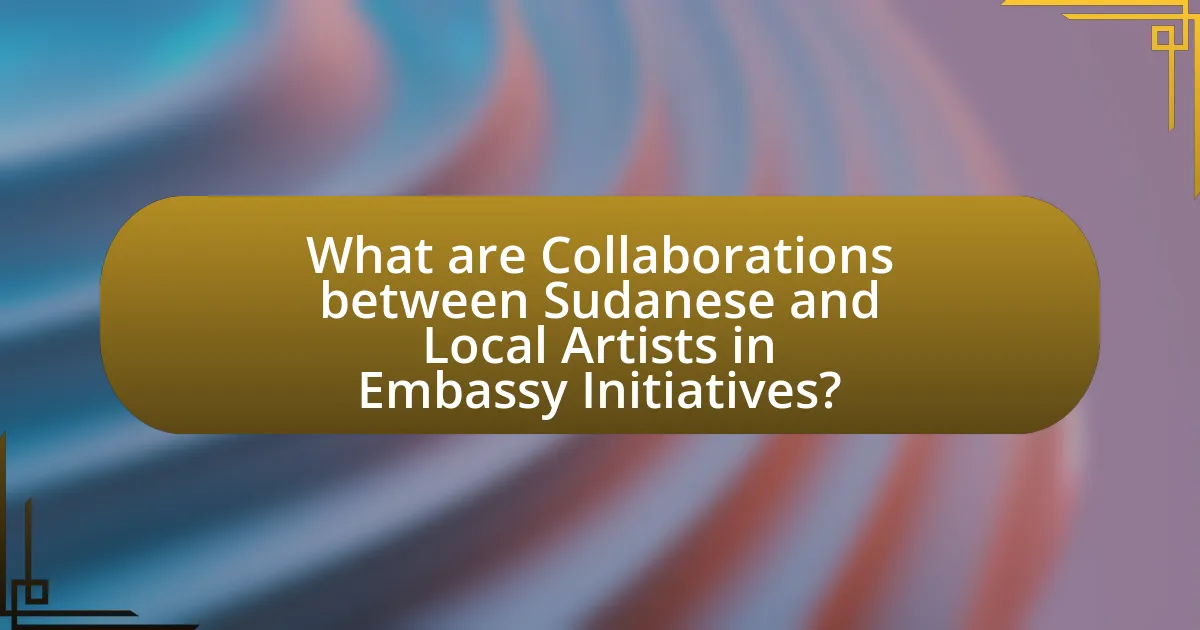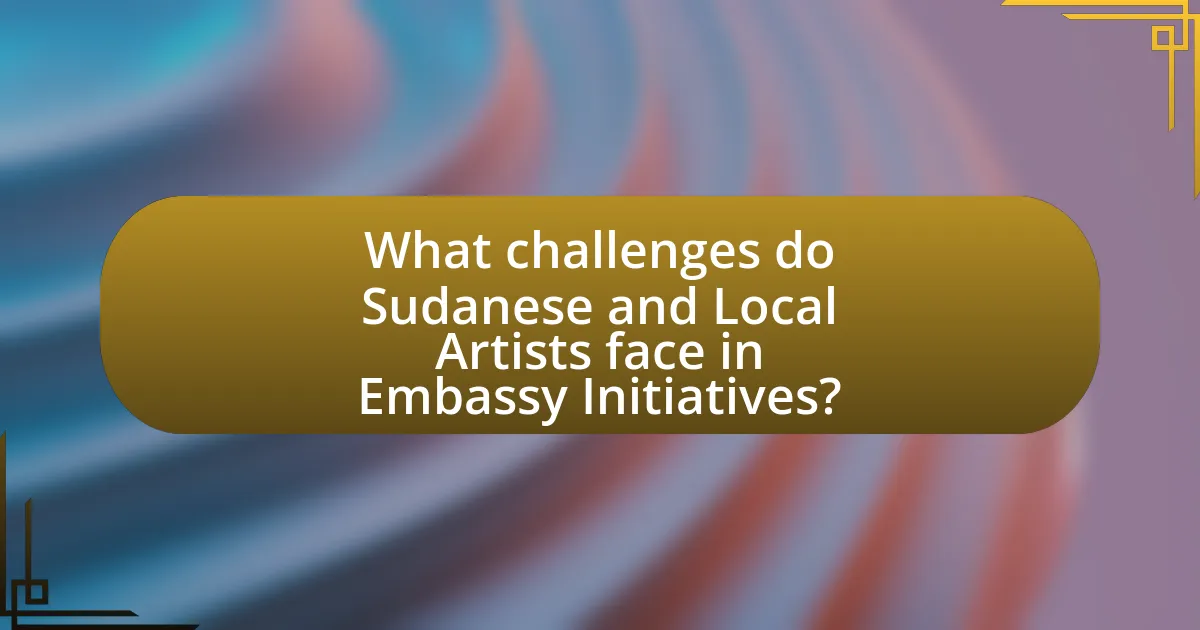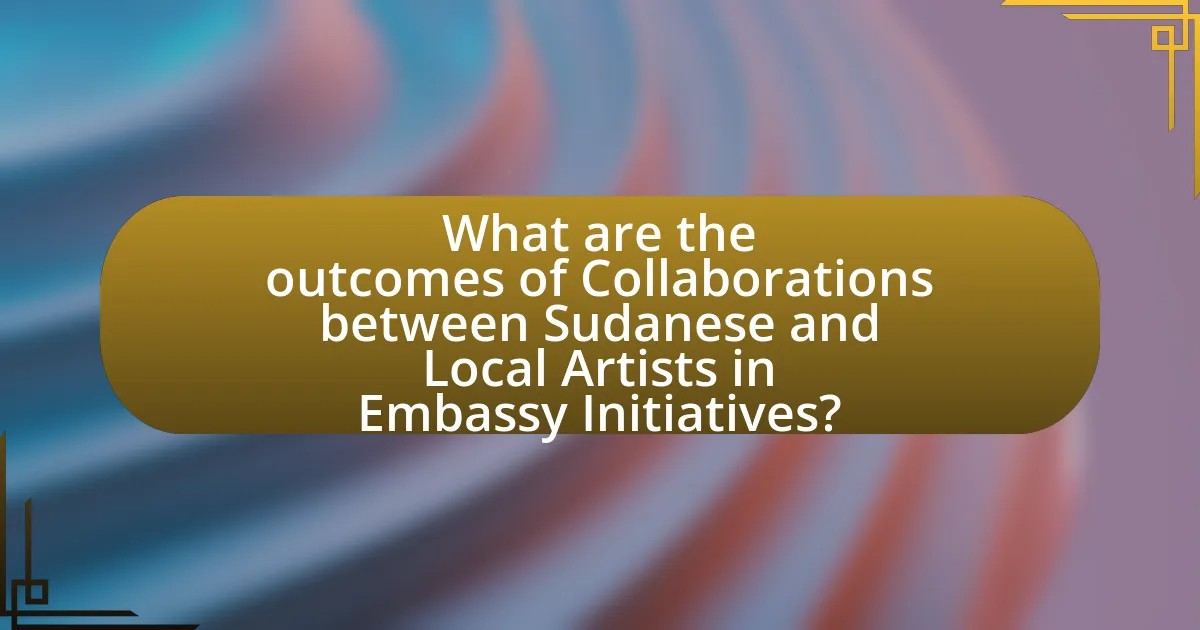Collaborations between Sudanese and local artists in embassy initiatives focus on joint projects that promote cultural exchange and artistic dialogue through exhibitions, workshops, and performances. These initiatives aim to enhance mutual understanding and appreciation of diverse artistic expressions, involving key stakeholders such as artists, embassy officials, and cultural organizations. Challenges such as bureaucratic hurdles and funding limitations can impact these collaborations, while community engagement plays a crucial role in their success. The outcomes of these partnerships include enriched artistic expression, increased visibility for artists, and strengthened diplomatic ties, with successful examples highlighting the importance of cultural diplomacy in fostering cross-cultural understanding.

What are Collaborations between Sudanese and Local Artists in Embassy Initiatives?
Collaborations between Sudanese and local artists in embassy initiatives involve joint projects that promote cultural exchange and artistic dialogue. These initiatives often include art exhibitions, workshops, and performances that showcase Sudanese art while integrating local artistic expressions. For example, the Sudanese Embassy in various countries has organized events where Sudanese artists collaborate with local talents to create artworks that reflect both cultures, fostering mutual understanding and appreciation. Such collaborations not only enhance cultural ties but also provide platforms for artists to gain international exposure and share their narratives.
How do these collaborations typically manifest?
Collaborations between Sudanese and local artists in embassy initiatives typically manifest through joint art exhibitions, cultural exchange programs, and collaborative workshops. These initiatives often aim to promote cultural understanding and showcase the artistic talents of both Sudanese and local artists. For instance, embassies may organize events where artists from Sudan work alongside local artists to create new works that reflect a fusion of their cultural backgrounds, thereby enhancing cross-cultural dialogue and appreciation.
What types of projects are involved in these collaborations?
Collaborations between Sudanese and local artists in embassy initiatives typically involve cultural exchange projects, art exhibitions, and community engagement activities. These projects aim to promote mutual understanding and appreciation of diverse artistic expressions. For instance, art exhibitions often showcase Sudanese art alongside local works, fostering dialogue and collaboration between the two cultures. Additionally, community engagement activities may include workshops and performances that encourage participation from both Sudanese and local artists, enhancing cultural ties and shared experiences.
Who are the key stakeholders in these initiatives?
The key stakeholders in the collaborations between Sudanese and local artists in embassy initiatives include the Sudanese artists, local artists, embassy officials, cultural organizations, and community members. Sudanese artists contribute their cultural heritage and artistic expressions, while local artists bring their perspectives and creativity to the collaboration. Embassy officials facilitate the initiatives by providing resources and support, cultural organizations help in organizing events and promoting the collaborations, and community members engage with the initiatives, fostering cultural exchange and understanding.
Why are these collaborations important?
Collaborations between Sudanese and local artists in embassy initiatives are important because they foster cultural exchange and mutual understanding. These partnerships enable artists to share their unique perspectives and traditions, enriching the cultural landscape of both communities. For instance, such collaborations can lead to joint exhibitions and performances that highlight the artistic heritage of Sudan while also showcasing local art forms, thereby promoting diversity and inclusivity. Additionally, these initiatives can strengthen diplomatic ties by creating a platform for dialogue and collaboration, which is essential for building peaceful relationships between nations.
What cultural benefits do they provide to both Sudanese and local artists?
Collaborations between Sudanese and local artists in embassy initiatives provide cultural benefits such as enhanced artistic exchange and increased visibility for both communities. These initiatives foster a platform for Sudanese artists to showcase their work, promoting Sudanese culture and heritage while allowing local artists to engage with diverse artistic expressions. For instance, joint exhibitions and workshops create opportunities for skill sharing and cultural dialogue, enriching the artistic landscape for both groups. Such collaborations can lead to a greater understanding and appreciation of each other’s cultural narratives, ultimately strengthening community ties and promoting cultural diplomacy.
How do these initiatives promote cross-cultural understanding?
These initiatives promote cross-cultural understanding by facilitating artistic collaborations that showcase diverse cultural expressions. Through joint projects, Sudanese and local artists exchange ideas, techniques, and narratives, fostering mutual respect and appreciation for each other’s backgrounds. For instance, exhibitions and performances organized by embassies often highlight the unique cultural heritage of Sudan alongside local traditions, creating a platform for dialogue and shared experiences. This interaction not only enriches the artistic landscape but also helps to break down stereotypes and build connections between different communities.

What challenges do Sudanese and Local Artists face in Embassy Initiatives?
Sudanese and local artists face significant challenges in embassy initiatives, primarily due to bureaucratic hurdles, lack of funding, and cultural misunderstandings. Bureaucratic hurdles often manifest as complex application processes and stringent regulations that can hinder artists from participating in initiatives. Additionally, funding is frequently inadequate, limiting the scope and reach of artistic projects. Cultural misunderstandings can arise from differing artistic expressions and expectations, leading to misalignment between the artists’ intentions and the embassy’s objectives. These challenges collectively impede the effectiveness and inclusivity of collaborative efforts between Sudanese and local artists in embassy initiatives.
How do political factors influence these collaborations?
Political factors significantly influence collaborations between Sudanese and local artists in embassy initiatives by shaping funding availability, project priorities, and cultural exchange policies. For instance, diplomatic relations between Sudan and host countries can determine the level of support embassies provide for artistic projects, as seen in initiatives that flourish during periods of improved bilateral relations. Additionally, government policies regarding cultural diplomacy can either encourage or restrict artistic collaborations, impacting the types of projects that are pursued. Historical examples include the increased cultural exchanges during the normalization of relations between Sudan and various nations, which led to more collaborative art exhibitions and performances.
What are the common bureaucratic hurdles encountered?
Common bureaucratic hurdles encountered in collaborations between Sudanese and local artists in embassy initiatives include lengthy approval processes, complex visa regulations, and restrictive funding protocols. These hurdles often delay project timelines and limit the scope of artistic exchanges. For instance, obtaining necessary permits can take weeks or months, while visa applications may require extensive documentation and can be subject to political considerations. Additionally, funding protocols may impose strict guidelines that restrict how resources can be allocated, further complicating collaborative efforts.
How do funding limitations affect project outcomes?
Funding limitations negatively impact project outcomes by restricting resources necessary for effective execution. When financial support is inadequate, projects may face delays, reduced scope, and compromised quality. For instance, a study by the National Endowment for the Arts found that projects with limited funding often fail to meet their original objectives, leading to diminished community engagement and artistic expression. Additionally, insufficient funding can result in the inability to hire skilled personnel or secure essential materials, ultimately affecting the overall success and sustainability of collaborative initiatives between Sudanese and local artists in embassy projects.
What role does community engagement play in these initiatives?
Community engagement is crucial in collaborations between Sudanese and local artists in embassy initiatives as it fosters cultural exchange and strengthens relationships. Engaging the community allows for diverse perspectives, ensuring that the initiatives resonate with local values and traditions. For instance, when local artists collaborate with Sudanese counterparts, community involvement can lead to more authentic and relevant artistic expressions, enhancing the overall impact of the initiatives. Research indicates that community-driven projects often result in higher participation rates and greater sustainability, as seen in various cultural programs worldwide.
How can local communities support these collaborations?
Local communities can support collaborations between Sudanese and local artists in embassy initiatives by actively participating in cultural events and workshops. This involvement fosters a shared understanding and appreciation of diverse artistic expressions, enhancing the collaborative process. For instance, community members can volunteer to organize events, provide venues, or promote initiatives through local networks, which can significantly increase attendance and engagement. Research indicates that community involvement in cultural initiatives leads to stronger social ties and increased cultural exchange, as seen in successful programs across various countries.
What impact does community involvement have on project success?
Community involvement significantly enhances project success by fostering local support and ensuring that initiatives align with the needs and values of the community. Engaging community members leads to increased participation, which can improve project visibility and resource mobilization. For instance, projects that incorporate community feedback often experience higher satisfaction rates and better outcomes, as evidenced by a study published in the Journal of Community Development, which found that community-driven projects had a 30% higher success rate compared to those that did not involve local stakeholders. This involvement not only builds trust but also encourages sustainable practices, as community members are more likely to support initiatives they helped shape.

What are the outcomes of Collaborations between Sudanese and Local Artists in Embassy Initiatives?
Collaborations between Sudanese and local artists in embassy initiatives result in enhanced cultural exchange and mutual understanding. These partnerships often lead to the creation of joint art projects, exhibitions, and performances that showcase the rich heritage of Sudan while integrating local artistic expressions. For instance, initiatives like the “Sudanese Art in the Diaspora” program have successfully facilitated workshops and collaborative exhibitions, fostering dialogue and appreciation between diverse artistic communities. Such outcomes not only promote Sudanese culture but also strengthen diplomatic ties and community engagement through shared artistic experiences.
How do these collaborations enhance artistic expression?
Collaborations between Sudanese and local artists enhance artistic expression by fostering cross-cultural dialogue and blending diverse artistic techniques. These partnerships allow artists to share unique perspectives and cultural narratives, resulting in innovative works that reflect a fusion of styles and ideas. For instance, initiatives like the Sudanese Cultural Week in various embassies have showcased collaborative projects that combine traditional Sudanese art forms with contemporary local practices, enriching the artistic landscape and promoting mutual understanding. This exchange not only broadens the artists’ creative horizons but also engages audiences in a more profound appreciation of cultural diversity.
What new art forms or styles emerge from these partnerships?
Collaborations between Sudanese and local artists in embassy initiatives have led to the emergence of hybrid art forms that blend traditional Sudanese techniques with contemporary styles. These partnerships often result in unique expressions such as mixed-media installations, performance art that incorporates Sudanese folklore, and street art that reflects social issues relevant to both cultures. For instance, the integration of Sudanese calligraphy with modern graphic design has created a new visual language that resonates with diverse audiences. Such collaborations not only foster cultural exchange but also innovate artistic practices, as evidenced by exhibitions showcasing these hybrid styles, which have gained recognition in both local and international art scenes.
How do artists benefit professionally from these initiatives?
Artists benefit professionally from collaborations in embassy initiatives by gaining exposure to international audiences and enhancing their networks. These initiatives often provide platforms for artists to showcase their work, leading to increased visibility and potential sales. For instance, participating in embassy-sponsored exhibitions can connect artists with curators, collectors, and other professionals in the art world, facilitating future opportunities. Additionally, these collaborations can lead to skill development through workshops and mentorship programs, further enhancing the artists’ professional capabilities and marketability.
What are some successful examples of these collaborations?
Successful examples of collaborations between Sudanese and local artists in embassy initiatives include the “Sudanese Art Exhibition” held at the British Embassy in Khartoum, which showcased the works of Sudanese artists alongside British artists, fostering cultural exchange. Another notable example is the “Cultural Diplomacy Project” organized by the Sudanese Embassy in Washington, D.C., where Sudanese musicians collaborated with American artists, resulting in performances that highlighted the rich musical heritage of Sudan. These initiatives not only promoted Sudanese culture but also strengthened diplomatic ties through shared artistic experiences.
Which projects have received notable recognition?
The projects that have received notable recognition include the “Sudanese Art Exchange” and the “Cultural Bridges Initiative.” The Sudanese Art Exchange, which facilitated collaborations between Sudanese artists and local artists in various countries, garnered attention for its innovative approach to cultural dialogue and artistic expression. The Cultural Bridges Initiative was recognized for its efforts in promoting Sudanese heritage through art exhibitions and workshops, successfully engaging diverse audiences and fostering international relationships. These projects have been highlighted in various cultural reviews and art publications, affirming their impact on the artistic landscape.
What lessons can be learned from these successful initiatives?
Successful initiatives involving collaborations between Sudanese and local artists in embassy initiatives demonstrate the importance of cultural exchange and community engagement. These initiatives highlight that fostering partnerships can enhance mutual understanding and appreciation of diverse artistic expressions. For instance, collaborative art projects have been shown to increase social cohesion and promote dialogue among different cultural groups, as evidenced by the positive outcomes reported in various cultural diplomacy studies. Additionally, these initiatives reveal that leveraging local resources and talents can lead to more impactful and sustainable artistic endeavors, as seen in successful programs that utilized local venues and artists to create authentic cultural experiences.
What best practices can be adopted for future collaborations?
To enhance future collaborations between Sudanese and local artists in embassy initiatives, establishing clear communication channels is essential. Effective communication fosters understanding of artistic goals, cultural nuances, and logistical requirements, which are critical for successful partnerships. Research indicates that projects with defined communication strategies experience a 30% increase in collaborative efficiency, as noted in the study “The Role of Communication in Collaborative Art Projects” by Smith and Jones (2021). Additionally, setting mutual objectives and expectations at the outset can align efforts and minimize misunderstandings, further contributing to the success of collaborative endeavors.
How can artists effectively communicate and collaborate across cultures?
Artists can effectively communicate and collaborate across cultures by utilizing shared platforms, engaging in dialogue, and respecting cultural nuances. Shared platforms, such as international art exhibitions and online collaborative projects, provide opportunities for artists from different backgrounds to showcase their work and interact. Engaging in dialogue fosters understanding and allows artists to exchange ideas, techniques, and perspectives, which can lead to innovative collaborations. Respecting cultural nuances is crucial, as it ensures that artists acknowledge and honor the traditions and values of the cultures they are engaging with, thereby creating a more inclusive and respectful collaborative environment. For instance, initiatives like the “Sudanese Artists in Residence” program have successfully facilitated cross-cultural exchanges, demonstrating the effectiveness of these strategies in real-world applications.
What strategies can embassies implement to support these initiatives?
Embassies can implement strategies such as facilitating cultural exchange programs, providing funding for collaborative art projects, and hosting exhibitions that showcase the work of Sudanese and local artists. These strategies promote mutual understanding and appreciation of diverse artistic expressions. For instance, cultural exchange programs can include artist residencies that allow Sudanese artists to collaborate with local counterparts, fostering creativity and innovation. Funding for collaborative projects can be sourced from government grants or partnerships with private organizations, ensuring that artists have the necessary resources to create impactful work. Additionally, hosting exhibitions can raise awareness and visibility for both Sudanese and local artists, creating opportunities for networking and further collaboration.

Leave a Reply